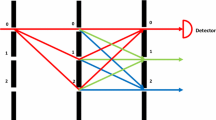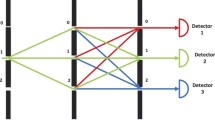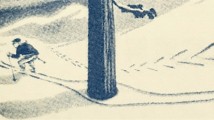Abstract
In this article, we make a review on the development of a newly proposed quantum computer, duality computer, or the duality quantum computer and the duality mode of quantum computers. The duality computer is based on the particle-wave duality principle of quantum mechanics. Compared to an ordinary quantum computer, the duality quantum computer is a quantum computer on the move and passing through a multi-slit. It offers more computing operations than is possible with an ordinary quantum computer. The most two distinct operations are: the quantum division operation and the quantum combiner operation. The division operation divides the wave function of a quantum computer into many attenuated, and identical parts. The combiner operation combines the wave functions in different parts into a single part. The duality mode is a way in which a quantum computer with some extra qubit resource simulates a duality computer. The main structure of duality quantum computer and duality mode, the duality mode, their mathematical description and algorithm designs are reviewed.
Similar content being viewed by others
Explore related subjects
Discover the latest articles and news from researchers in related subjects, suggested using machine learning.References
Long G L. The general quantum interference principle and the duality computer. Communications in Theoretical Physics, 2006, 45(5): 825–844; Also see arXiv:quant-ph/0512120; It was briefly mentioned in an abstract (5111-53) (Tracking No. FN03-FN02-32) submitted to SPIE conference “Fluctuations and Noise in Photonics and Quantum Optics” in 18 Oct 2002
Arndt M, Nairz O, Vos-Andreae J, et al. Wave-particle duality of C60 molecules. Nature, 1999, 401: 680–682
Liu Y, Long G L. Duality computing in quantum computers. arXiv: 0708.1986, accepted by Communications in Theoretical Physics
Liu Y, Wang C, Long G L. Allowable generalized quantum gates. accepted by Communications in Theoretical Physics
Wang Y Q, Du H K, Dou Y N. Note on generalized quantum gates and quantum operations. International Journal of Theoretical Physics, (in press). Online first with DOI 10.1007/s10773-008-9659-4
Gudder S. Mathematical theory of duality quantum computers. Quantum Information Processing, 2007, 6(1): 37–48
Long G L. Mathematical theory of the duality computer in the density matrix formalism. Quantum Information Processing, 2007, 6(1): 49–54
Gudder S. Duality quantum computers and quantum operations. International Journal of Theoretical Physics, 2008, 47(1): 268–279. See also http://www.math.du.edu/data/preprints/m0611.pdf
Du H K, Wang Y Q, Xu J L. Applications of the generalized Luders theorem. Journal of Mathematical Physics, 2008, 49(1): 013507
Wootters W, Zurek W. A single quantum cannot be cloned. Nature, 1982, 299: 802–803
Deutsch D. Quantum computational networks. Proceedings of the Royal Society London A, 1989, 425: 73–90
Barenco A, Bennett C H, Cleve R, et al. Elementary gates for quantum computation. Physical Review A, 1995, 52(5): 3457–3466
Long G L, Zhou Y F, Jin J Q, et al. Density matrix in quantum mechanics and distinctness of ensembles having the same compressed density matrix. Foundations of Physics, 2006, 36(8): 1217–1243
Long G L, Liu Y. Search an unsorted database with quantum mechanics. Frontiers of Computer Science in China, 2007, 1(3): 247–271
Grover L. A fast quantum mechanical algorithm for database search. In: Proceedings of 28th Annual ACM Symposium on Theory of Computing. ACM New York, 1996: 212–219
Long G L. Grover algorithm with zero theoretical rate. Physical Review A, 2001, 64: 022307
Bruuschweiler R. Novel strategy for database searching in spin Liouville space by NMR ensemble computing. Physical Review Letters, 2000, 85(22): 4815–4818
Xiao L, Long G L. Fetching marked items from an unsorted database in NMR ensemble computing. Physical Review A, 2002, 66(5): 052320
Long G L, Xiao L. Parallel quantum computing in a single ensemble quantum computer. Physical Review A, 2004, 69(6): 052302
Long G L, Xiao L. Experimental realization of a fetching algorithm in a 7-qubit NMR spin Liouville space computer. Journal of Chemical Physics, 2003, 119(16): 8473–8481
Grover L K. Fixed-point quantum search. Physical Review Letters, 2005, 95(15): 150501
Li D F, Li X R, Huang H T, et al. Fixed-point quantum search for different phase shifts. Physics Letters A, 2007, 362(4): 260–264
Li D F. Quantum fixed-point search algorithm with general phase shifts. Frontiers of Computer Science in China, 2008, 2(2): 138–142
Wang W Y, Shang B, Wang C, et al. Prime factorization in the duality computer. Communications in Theoretical Physics, 2007, 47(3): 471–473
Qiu D W, Li L Z. An overview of quantum computation models: quantum automata. Frontiers of Computer Science in China, 2008, 2(2): 193–207
Author information
Authors and Affiliations
Corresponding author
Rights and permissions
About this article
Cite this article
Long, G., Liu, Y. Duality quantum computing. Front. Comput. Sci. China 2, 167–178 (2008). https://doi.org/10.1007/s11704-008-0021-z
Received:
Accepted:
Published:
Issue Date:
DOI: https://doi.org/10.1007/s11704-008-0021-z




